(英语毕业论文)中西医文化差异下中医英语翻译的障碍
中西文化差异对英语翻译的影响与对策
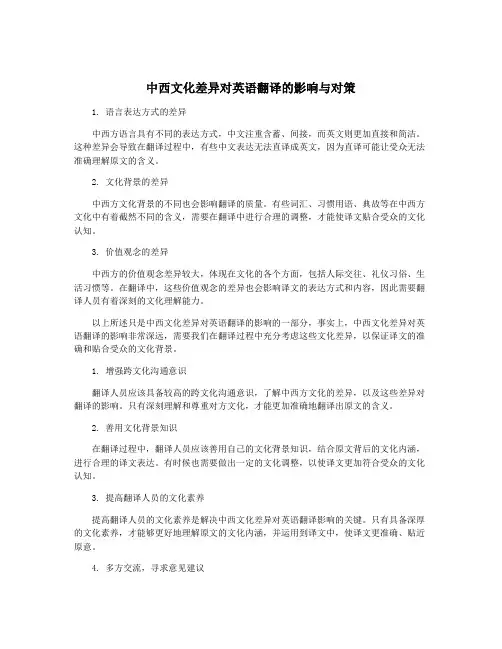
中西文化差异对英语翻译的影响与对策1. 语言表达方式的差异中西方语言具有不同的表达方式,中文注重含蓄、间接,而英文则更加直接和简洁。
这种差异会导致在翻译过程中,有些中文表达无法直译成英文,因为直译可能让受众无法准确理解原文的含义。
2. 文化背景的差异中西方文化背景的不同也会影响翻译的质量。
有些词汇、习惯用语、典故等在中西方文化中有着截然不同的含义,需要在翻译中进行合理的调整,才能使译文贴合受众的文化认知。
3. 价值观念的差异中西方的价值观念差异较大,体现在文化的各个方面,包括人际交往、礼仪习俗、生活习惯等。
在翻译中,这些价值观念的差异也会影响译文的表达方式和内容,因此需要翻译人员有着深刻的文化理解能力。
以上所述只是中西文化差异对英语翻译的影响的一部分,事实上,中西文化差异对英语翻译的影响非常深远,需要我们在翻译过程中充分考虑这些文化差异,以保证译文的准确和贴合受众的文化背景。
1. 增强跨文化沟通意识翻译人员应该具备较高的跨文化沟通意识,了解中西方文化的差异,以及这些差异对翻译的影响。
只有深刻理解和尊重对方文化,才能更加准确地翻译出原文的含义。
2. 善用文化背景知识在翻译过程中,翻译人员应该善用自己的文化背景知识,结合原文背后的文化内涵,进行合理的译文表达。
有时候也需要做出一定的文化调整,以使译文更加符合受众的文化认知。
3. 提高翻译人员的文化素养提高翻译人员的文化素养是解决中西文化差异对英语翻译影响的关键。
只有具备深厚的文化素养,才能够更好地理解原文的文化内涵,并运用到译文中,使译文更准确、贴近原意。
4. 多方交流,寻求意见建议在翻译过程中,可以多方交流,寻求意见建议。
可以向具有丰富跨文化经验的专家或者老师请教,获取更多的文化相关信息,以及在翻译过程中的指导和建议。
5. 进行文化背景调查在翻译之前,进行文化背景调查也是十分重要的,可以通过查阅相关资料,了解原文所涉及的文化内涵和背景信息,从而有助于更好地理解原文,以及更准确地翻译出原文的含义。
中西医文化背景不同英语作文
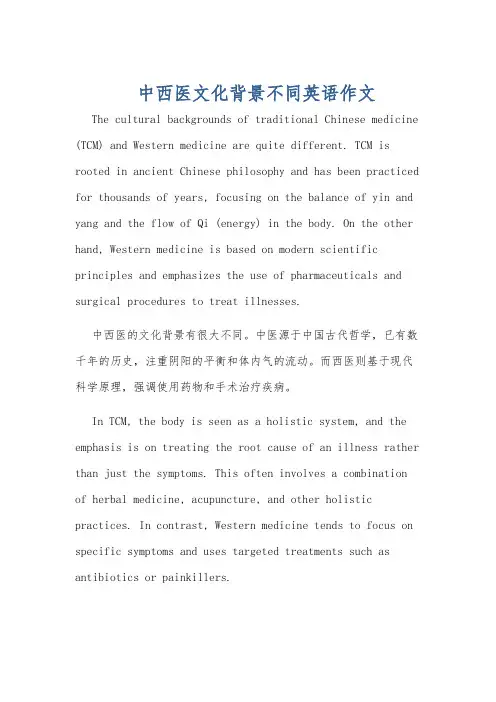
中西医文化背景不同英语作文The cultural backgrounds of traditional Chinese medicine (TCM) and Western medicine are quite different. TCM is rooted in ancient Chinese philosophy and has been practiced for thousands of years, focusing on the balance of yin and yang and the flow of Qi (energy) in the body. On the other hand, Western medicine is based on modern scientific principles and emphasizes the use of pharmaceuticals and surgical procedures to treat illnesses.中西医的文化背景有很大不同。
中医源于中国古代哲学,已有数千年的历史,注重阴阳的平衡和体内气的流动。
而西医则基于现代科学原理,强调使用药物和手术治疗疾病。
In TCM, the body is seen as a holistic system, and the emphasis is on treating the root cause of an illness rather than just the symptoms. This often involves a combination of herbal medicine, acupuncture, and other holistic practices. In contrast, Western medicine tends to focus on specific symptoms and uses targeted treatments such as antibiotics or painkillers.在中医中,人体被视为一个整体系统,强调治疗疾病的根本原因而不仅仅是症状。
英汉文化差异对中医英语翻译技能的影响
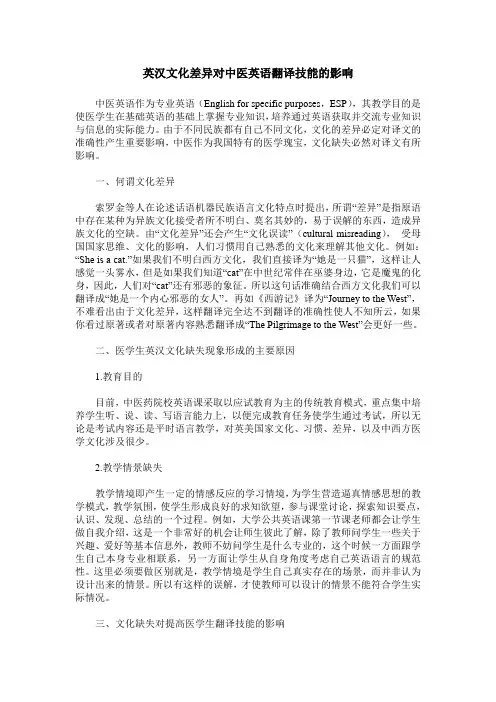
英汉文化差异对中医英语翻译技能的影响中医英语作为专业英语(English for specific purposes,ESP),其教学目的是使医学生在基础英语的基础上掌握专业知识,培养通过英语获取并交流专业知识与信息的实际能力。
由于不同民族都有自己不同文化,文化的差异必定对译文的准确性产生重要影响,中医作为我国特有的医学瑰宝,文化缺失必然对译文有所影响。
一、何谓文化差异索罗金等人在论述话语机器民族语言文化特点时提出,所谓“差异”是指原语中存在某种为异族文化接受者所不明白、莫名其妙的,易于误解的东西,造成异族文化的空缺。
由“文化差异”还会产生“文化误读”(cultural misreading),受母国国家思维、文化的影响,人们习惯用自己熟悉的文化来理解其他文化。
例如:“She is a cat.”如果我们不明白西方文化,我们直接译为“她是一只猫”,这样让人感觉一头雾水,但是如果我们知道“cat”在中世纪常伴在巫婆身边,它是魔鬼的化身,因此,人们对“cat”还有邪恶的象征。
所以这句话准确结合西方文化我们可以翻译成“她是一个内心邪恶的女人”。
再如《西游记》译为“Journey to the West”,不难看出由于文化差异,这样翻译完全达不到翻译的准确性使人不知所云,如果你看过原著或者对原著内容熟悉翻译成“The Pilgrimage to the West”会更好一些。
二、医学生英汉文化缺失现象形成的主要原因1.教育目的目前,中医药院校英语课采取以应试教育为主的传统教育模式,重点集中培养学生听、说、读、写语言能力上,以便完成教育任务使学生通过考试,所以无论是考试内容还是平时语言教学,对英美国家文化、习惯、差异,以及中西方医学文化涉及很少。
2.教学情景缺失教学情境即产生一定的情感反应的学习情境,为学生营造逼真情感思想的教学模式,教学氛围,使学生形成良好的求知欲望,参与课堂讨论,探索知识要点,认识、发现、总结的一个过程。
中西医区别英语作文
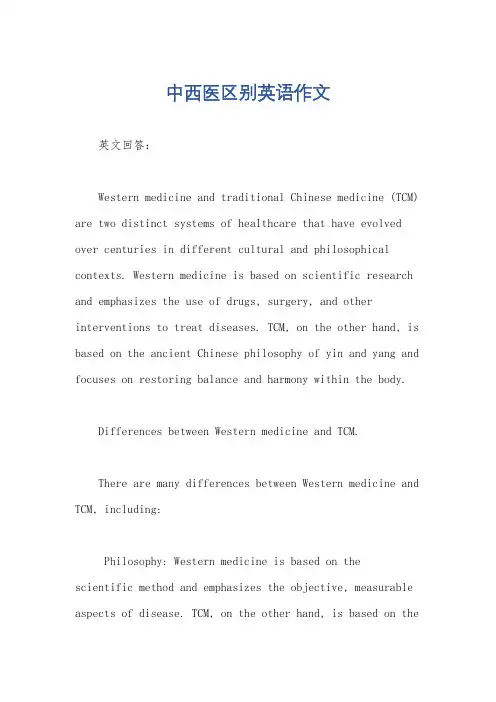
中西医区别英语作文英文回答:Western medicine and traditional Chinese medicine (TCM) are two distinct systems of healthcare that have evolved over centuries in different cultural and philosophical contexts. Western medicine is based on scientific research and emphasizes the use of drugs, surgery, and other interventions to treat diseases. TCM, on the other hand, is based on the ancient Chinese philosophy of yin and yang and focuses on restoring balance and harmony within the body.Differences between Western medicine and TCM.There are many differences between Western medicine and TCM, including:Philosophy: Western medicine is based on thescientific method and emphasizes the objective, measurable aspects of disease. TCM, on the other hand, is based on theancient Chinese philosophy of yin and yang and focuses onthe balance and harmony of the body.Treatment: Western medicine typically uses drugs, surgery, and other interventions to treat diseases. TCM, on the other hand, uses a variety of therapies, including acupuncture, herbal medicine, and massage, to restore balance and harmony to the body.Diagnosis: Western medicine typically uses laboratory tests and imaging to diagnose diseases. TCM, on the other hand, uses a variety of techniques, including pulse taking and tongue examination, to diagnose diseases.Prevention: Western medicine typically focuses on treating diseases after they have developed. TCM, on the other hand, also emphasizes prevention and encourages patients to make lifestyle changes to maintain their health.Similarities between Western medicine and TCM.Despite their differences, Western medicine and TCMshare some similarities, including:Goal: Both Western medicine and TCM aim to improve the health of patients.Patient care: Both Western medicine and TCM emphasize the importance of patient care and providing individualized treatment plans.Research: Both Western medicine and TCM are engaged in research to improve their understanding of diseases and develop new treatments.Conclusion.Western medicine and TCM are two distinct systems of healthcare that have different philosophies, treatments, and diagnostic techniques. However, both systems share the goal of improving the health of patients and providing individualized care.中文回答:中医和西医的区别。
中医与西医的区别英语作文
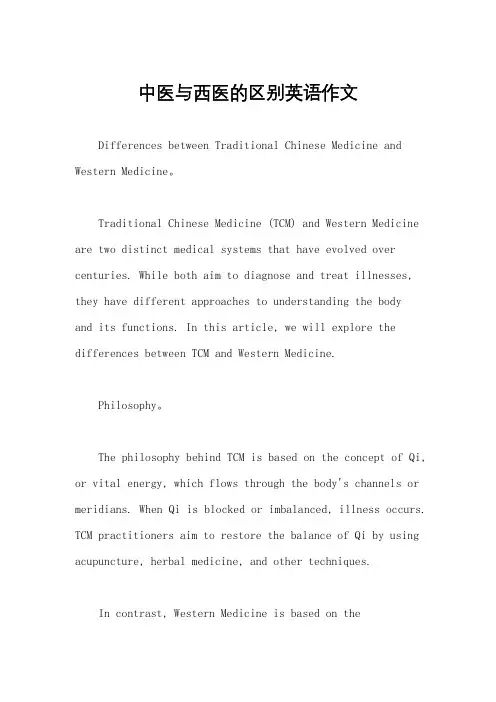
中医与西医的区别英语作文Differences between Traditional Chinese Medicine and Western Medicine。
Traditional Chinese Medicine (TCM) and Western Medicine are two distinct medical systems that have evolved over centuries. While both aim to diagnose and treat illnesses, they have different approaches to understanding the bodyand its functions. In this article, we will explore the differences between TCM and Western Medicine.Philosophy。
The philosophy behind TCM is based on the concept of Qi, or vital energy, which flows through the body's channels or meridians. When Qi is blocked or imbalanced, illness occurs. TCM practitioners aim to restore the balance of Qi by using acupuncture, herbal medicine, and other techniques.In contrast, Western Medicine is based on thescientific method and focuses on the physical and chemical processes of the body. It views the body as a machine that can be studied and understood through scientific inquiry. Western Medicine uses drugs, surgery, and otherinterventions to treat diseases.Diagnosis。
中西文化差异对英语翻译的影响与对策
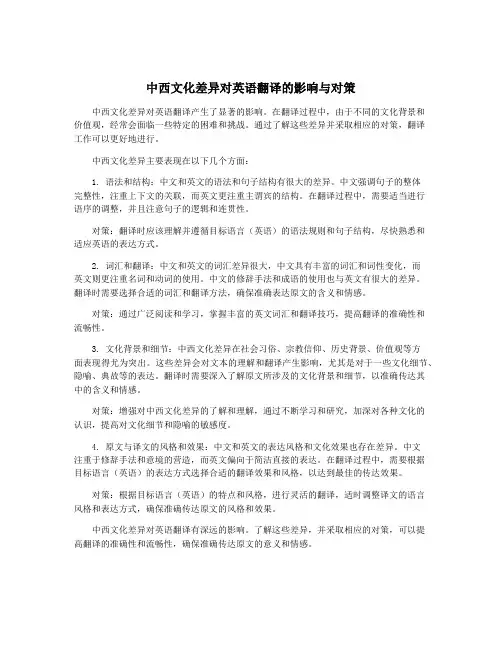
中西文化差异对英语翻译的影响与对策中西文化差异对英语翻译产生了显著的影响。
在翻译过程中,由于不同的文化背景和价值观,经常会面临一些特定的困难和挑战。
通过了解这些差异并采取相应的对策,翻译工作可以更好地进行。
中西文化差异主要表现在以下几个方面:1. 语法和结构:中文和英文的语法和句子结构有很大的差异。
中文强调句子的整体完整性,注重上下文的关联,而英文更注重主谓宾的结构。
在翻译过程中,需要适当进行语序的调整,并且注意句子的逻辑和连贯性。
对策:翻译时应该理解并遵循目标语言(英语)的语法规则和句子结构,尽快熟悉和适应英语的表达方式。
2. 词汇和翻译:中文和英文的词汇差异很大,中文具有丰富的词汇和词性变化,而英文则更注重名词和动词的使用。
中文的修辞手法和成语的使用也与英文有很大的差异。
翻译时需要选择合适的词汇和翻译方法,确保准确表达原文的含义和情感。
对策:通过广泛阅读和学习,掌握丰富的英文词汇和翻译技巧,提高翻译的准确性和流畅性。
3. 文化背景和细节:中西文化差异在社会习俗、宗教信仰、历史背景、价值观等方面表现得尤为突出。
这些差异会对文本的理解和翻译产生影响,尤其是对于一些文化细节、隐喻、典故等的表达。
翻译时需要深入了解原文所涉及的文化背景和细节,以准确传达其中的含义和情感。
对策:增强对中西文化差异的了解和理解,通过不断学习和研究,加深对各种文化的认识,提高对文化细节和隐喻的敏感度。
4. 原文与译文的风格和效果:中文和英文的表达风格和文化效果也存在差异。
中文注重于修辞手法和意境的营造,而英文偏向于简洁直接的表达。
在翻译过程中,需要根据目标语言(英语)的表达方式选择合适的翻译效果和风格,以达到最佳的传达效果。
对策:根据目标语言(英语)的特点和风格,进行灵活的翻译,适时调整译文的语言风格和表达方式,确保准确传达原文的风格和效果。
中西文化差异对英语翻译有深远的影响。
了解这些差异,并采取相应的对策,可以提高翻译的准确性和流畅性,确保准确传达原文的意义和情感。
中西医文化背景不同英语作文
中西医文化背景不同英语作文The cultural backgrounds of traditional Chinese medicine and Western medicine are quite different.中西医文化背景差异巨大,这种差异不仅体现在医学理论和实践上,还体现在医疗体系和治疗方法上。
Traditional Chinese medicine, with a history of thousands of years, is based on the principles of Yin and Yang, Qi, meridians, and the Five Elements.传统中医源远流长,以阴阳、气血、经络、五行等理论为基础。
Its focus is on balancing the body's energy flow and restoring harmony between the body, mind, and spirit.中医注重平衡身体的能量流动,恢复身心灵的和谐。
On the other hand, Western medicine is founded on the principles of biological and physiological research, focusing on identifying and treating specific diseases through theuse of pharmaceuticals and surgeries.而西医则以生物和生理学为基础,通过药物和手术治疗来诊断和治疗特定疾病。
One of the key differences between the two medical systems is their approach to diagnosis.其中一个主要的区别是两种医学体系对诊断的方式。
关于中西医差异的英语作文
关于中西医差异的英语作文In the realm of healthcare, the world has witnessed a myriad of medical practices, with two of the most prominent being Traditional Chinese Medicine (TCM) and Western Medicine. These two systems have been developed independently over centuries and offer distinct approaches to diagnosing and treating illnesses. This essay aims to explore the fundamental differences between TCM and Western Medicine in terms of their philosophies, diagnostic methods, treatment modalities, and cultural implications.Philosophical FoundationsAt the core of TCM is the belief in the balance of Qi (life energy) and the harmony of the body's systems, which are influenced by the natural world. It emphasizes a holistic approach, considering the body, mind, and spirit as interconnected. Western Medicine, on the other hand, is grounded in scientific principles and focuses on a more reductionist approach, targeting specific diseases or symptoms with precise interventions.Diagnostic MethodsTCM practitioners often use observations of the tongue, pulse diagnosis, and patient interviews to understand the imbalances within the body. This method is highly individualized and takes into account the patient's overallwell-being. Conversely, Western Medicine relies heavily on technological tools such as laboratory tests, imaging, and other diagnostic procedures to identify the exact nature and location of a disease.Treatment ModalitiesTreatment in TCM can involve a variety of methods, including herbal remedies, acupuncture, cupping, and dietary adjustments. The goal is to restore balance and allow the body to heal itself. Western Medicine typically employs pharmaceuticals, surgery, and other medical procedures that directly target the disease or condition. This approach is often more aggressive and aims for a quick resolution of the symptoms.Cultural ImplicationsThe practice of TCM is deeply rooted in Chinese culture and has been passed down through generations, reflecting a respect for ancient wisdom and the natural order. Western Medicine has evolved with modern technology and is often seen as a symbol of progress and innovation. The cultural significance of each system influences public perception and the integration of these practices into daily life.Integration and ChallengesIn recent years, there has been a growing interest in integrating TCM and Western Medicine to create a more comprehensive healthcare system. This integration, however,faces challenges such as regulatory standards, scientific validation, and cultural acceptance. Despite these hurdles, many patients and practitioners recognize the value of a pluralistic approach to healthcare.ConclusionThe differences between Traditional Chinese Medicine and Western Medicine are as profound as they are complementary. While TCM offers a holistic and preventative approach, Western Medicine provides evidence-based and targeted treatments. As the global community continues to grapple with health challenges, the potential for a synergistic approach that leverages the strengths of both systems holds promisefor the future of healthcare.This essay has outlined the key distinctions between TCM and Western Medicine, highlighting their unique characteristics and the potential for their integration in a modern healthcare context. Understanding these differences iscrucial for patients seeking the best possible care and for healthcare providers aiming to offer a diverse range of treatment options.。
浅析中西方文化差异与英语翻译论文
浅析中西方文化差异与英语翻译论文无论是在学习还是在工作中,大家都经常接触到论文吧,通过论文写作可以培养我们独立思考和创新的能力。
相信很多朋友都对写论文感到非常苦恼吧,下面是店铺精心整理的浅析中西方文化差异与英语翻译论文,欢迎大家借鉴与参考,希望对大家有所帮助!浅析中西方文化差异与英语翻译论文篇1摘要:翻译的本质是两种文化的交流。
文化的差异是一个译者必须要处理好的问题,如果处理不当就容易让读者产生歧义。
分析了中西方主要的文化差异,并对主要的差异进行了举例说明。
介绍了对于这种差异的基本翻译方法,它们分别是:异化法、归化法和音译法。
并对这些方法进行了解释。
关键词:文化差异;处理方法;异化法;归化法;音译法1、语言是社会的产物,是人类历史和文化的结晶它凝聚着一个民族世代相传的社会意识,历史文化,风俗习惯等各方面人类社会所有的特征。
不同的文化需要沟通。
沟通离不开翻译,可见文化及其交流是翻译发生的本源,翻译是文化交流的产物。
翻译教学和研究的经验表明:翻译理论和技巧必须建立在不同语言和文化的对比分析的基础上。
翻译之所以困难,归根结底是语言差异和文化差异。
英汉两种语言在表达方式上有相似之处,但2012年02月13日09时09分,《英语学习:英语论文:简析中西方文化差异与英语翻译[1]》由出国英语编辑整理。
2、译法汉语文化中特有的事物在英语文化中完全空缺,这时可采用音译法将具有特殊文化内涵的词语“移植”到英语文化中去。
如:“功夫”kong fu、“乌龙茶”oolong等。
许多采用音译法翻译的词语已成为英语中的外来词,被西方大众广泛接受。
3、结语语言是文化的一部分,也是文化的传承者。
文化依靠语言进行传播、交流。
东西方文化的差异对英汉互译产生了深远的影响。
因此对于译者来说熟悉中英两种文化甚至比掌握这两种语言更为重要。
翻译离不开文化,没有基于文化的翻译是达不到交流的目的的。
本文只列举了三种基本的翻译方法,对于文化意象处理的问题,并没有统一的翻译方法和公式,译者应根据上下文灵活处理。
中医西医的区别英语作文
中医西医的区别英语作文Traditional Chinese Medicine vs. Western Medicine。
Introduction:Medicine is an essential part of human life. Throughout history, different cultures have developed their own medical systems to diagnose and treat illnesses.Traditional Chinese Medicine (TCM) and Western Medicine are two prominent systems that have evolved over centuries. This essay aims to explore the differences between TCM and Western Medicine, highlighting their unique approaches to healthcare.Body:1. Origins and Philosophies:TCM:Originated in ancient China over 2,500 years ago.Based on the philosophies of Yin and Yang, Five Elements, and Qi.Emphasizes the balance and harmony of the body, mind, and spirit.Focuses on the prevention of diseases and maintaining overall well-being.Western Medicine:Originated in ancient Greece and Rome, with significant contributions from the Middle East.Based on the scientific method, anatomy, physiology, and biochemistry.Emphasizes evidence-based practices and the use of pharmaceuticals.Focuses on diagnosing and treating specific diseases.2. Diagnostic Methods:TCM:Diagnosis is based on observing the patient's appearance, tongue, pulse, and asking detailed questions about symptoms and medical history.Emphasizes the holistic assessment of the patient's overall health.TCM practitioners use techniques like tongue diagnosis, pulse diagnosis, and palpation to identify imbalances in the body's energy flow.Western Medicine:Diagnosis is based on laboratory tests, physical examinations, and medical imaging.Emphasizes the identification of specific diseases and their causes.Western medical practitioners rely on advanced technology and scientific evidence to diagnose illnesses accurately.3. Treatment Approaches:TCM:Treatment involves a combination of herbal medicine, acupuncture, dietary therapy, and exercises like Tai Chi and Qigong.TCM aims to restore the balance of Yin and Yang, promoting the body's natural healing abilities.Treatment plans are personalized according to the individual's constitution and specific symptoms.Western Medicine:Treatment primarily involves pharmaceutical drugs, surgery, and other invasive procedures.Western medicine focuses on eliminating symptoms and curing diseases.Treatment plans are standardized based on scientific research and clinical trials.4. Views on Health and Disease:TCM:Considers health as a state of balance between Yin and Yang energies.Disease is seen as an imbalance or blockage of Qi (energy) flow.TCM aims to restore balance and harmony to prevent and treat diseases.Western Medicine:Views health as the absence of disease.Diseases are caused by pathogens, genetic factors, or lifestyle choices.Western medicine focuses on diagnosing and treating diseases to restore health.Conclusion:Both Traditional Chinese Medicine and Western Medicine have their own unique approaches to healthcare. TCM focuses on holistic well-being, prevention, and restoring balance, while Western Medicine emphasizes scientific research, disease-specific treatments, and symptom management. In recent years, there has been a growing interest in integrating these two medical systems to provide comprehensive and personalized healthcare to patients. Understanding the differences between TCM and WesternMedicine can help individuals make informed decisions about their healthcare choices.。
- 1、下载文档前请自行甄别文档内容的完整性,平台不提供额外的编辑、内容补充、找答案等附加服务。
- 2、"仅部分预览"的文档,不可在线预览部分如存在完整性等问题,可反馈申请退款(可完整预览的文档不适用该条件!)。
- 3、如文档侵犯您的权益,请联系客服反馈,我们会尽快为您处理(人工客服工作时间:9:00-18:30)。
最新英语专业全英原创毕业论文,都是近期写作1 The Awakening of the Female Consciousness in Pride and Prejudice2 企业英文简介中的概念语法隐喻分析3 顺应理论视角下《红楼梦》中社交指示语的英译研究4 苔丝悲剧中乌托邦情结的探析5 “A Rose for Emily”中“Rose”寓意的新解6 简析班纳特太太的婚恋观7 从文化角度探析中英基本颜色词的比较和翻译8 论《飘》中斯嘉丽的精神源泉9 从归化和异化的角度对《小妇人》的两个中文译本的比较研究10 “集体无意识”理论观照下艾米莉的悲剧性11 情感教学在初中英语课堂中的理论和实践12 论《简爱》中的经济意识13 肢体语言在大学英语教学课堂中的应用14 从语用原则视角分析政治演讲中的语用策略15 浅议《女勇士》中的个人英雄主义16 微笑着流泪——欧亨利小说赏析17 A CP-based Analysis of Humor in Friends18 On the Principle of Elegance in the Translation of Business Contracts19 A Comparative Study on the Two Chinese V ersions of Tess of the D’urbervilles from the Perspective of Nida’s Dynamic Equivalence20 《麦田里的守望者》中霍尔顿成长悲剧的成因分析以及对当今青少年的启迪21 简奥斯汀对英国小说的贡献——以《傲慢与偏见》为例22 从标记理论看英语词汇性别歧视现象23 浅析构词法及其在英语词汇教学中的运用24 论《大卫科波菲尔》中人物个性与时代背景的关系25 英语谚语中的性别歧视26 An Analysis of Textual Functions of the English Passive Voice27 从饮食角度透析中西方文化差异28 跨文化交际视角下沉默行为的解析29 英国海洋文化对英语习语的影响30 Doomed Tragedy out of Desire-Driven Morbid Personalities in Nabokov’s Lolita31 浅析《蝇王》中的人性黑暗32 跨文化视域中的英汉动物隐喻比较研究33 课堂英语教学与网络英语教学的对比34 自然与自由之子--新女性戴茜米勒35 英汉语言中红色联想意义的比较36 英汉拒绝言语对比研究37 当代中美青年恭维言语行为对比研究38 解读《飘》中斯佳丽的形象39 论内莉丁恩在《呼啸山庄》中的作用40 An Analysis of the Different Meanings of Color Words between Western and Eastern Cultures41 《可以吃的女人》的女性主义解读42 跨文化交际中文化负迁移的原因及其对策研究43 从核辐射报道看英国报纸行文的语言特征4445 从电影片名翻译窥探中美文化差异46 合作原则下幽默的语用分析47 论《简爱》中话语的人际意义48 修辞在政治演讲中的作用--以奥巴马获胜演讲为例49 英语环境的营造对中学生英语学习的影响50 Analysis on Heathcliff's Personality in Wuthering Heights51 新闻标题中的对话性52 论英语新闻标题中修辞的汉译53 浅析中西价值观差异对跨文化交际的影响及其解决方法54 英汉形状类量词的隐喻认知分析55 浅谈简.奥斯丁《劝导》的反讽艺术56 商务英语中模糊限制语的语用学研究57 功能翻译理论关照下的新闻英语标题翻译58 从目的论角度分析商业电视广告中双关语的翻译59 设计中国际主义风格与民族主义风格的平衡60 英语新词汉译原则研究61 英汉白色词的文化象征意义及翻译62 形合与意合对比研究及翻译策略63 文化差异对商标翻译的影响及翻译策略64 中国英语与中式英语的对比研究——从英汉民族思维差异的角度65 An Analysis of the D Film Alice in Wonderland from the Perspective of Gothicism66 初中英语词汇教学法研究综述67 语法翻译法与交际法的对比研究68 从《绝望主妇》对比中美女性家庭观69 英语基本味觉词“甜/苦”的隐喻机制70 关于英语课堂中教师体态语的研究71 《宠儿》中黑人母亲角色的解读72 中外服装品牌英文标签语言的跨文化研究73 词块法在高中英语写作教学中的应用74 英语习语的来源与特点75 论《织工马南》中的象征意义76 文化差异对商务谈判的影响及策略77 On Human Nature in Frankenstein78 浅析公示语的翻译79 论奥巴马就职演讲词的排比修辞80 A Summary of Symbols of The Scarlet Letter81 肢体语言的文化趋同性研究82 从目的论的角度比较研究《茶馆》的两个英文译本83 在孤独中寻找自我——析《没有指针的钟》J.T.马龙的救赎84 功能翻译理论关照下的英汉商标翻译85 以学生为中心的英语词汇教学的研究86 礼貌策略的英汉对比研究—以《傲慢与偏见》及其译本为例87 从《简.爱》与《藻海无边》看女性话语权的缺失88 莎士比亚戏剧《哈姆雷特》中男主人公性格分析89 A Comparative Analysis Between Pride and Prejudice and The Portrait of a Lady from the Perspective of Feminism90 象征主义在《野性的呼唤》中的运用91 从美学角度浅析许渊冲《汉英对照唐诗三首》——“意音形”三美论92 透过《傲慢与偏见》看现代社会爱情观93 论马克.吐温的种族观--以《哈克贝利.芬历险记》为例94 从时代背景看《唐璜》中个人主义到人道主义的升华95 论中美广告中所反映的文化价值观差异96 Strategy Researches to Improve College Students’oral English97 从广告分析看中西方价值观的差异98 广告翻译中的语用失误研究99 家庭生活中的瑞普凡温克尔100 伍尔夫的悲剧—电影《时时刻刻》观后101 On the Difference of Family Education between China and America102 An Analysis on Feminism from the Perspective of Music in Little Women103 商务英语中的颜色词浅析104 《我的安东尼娅》中女性人物形象的生态女性主义分析105 英汉新闻标题中缩略词对比研究106 读者在文学文本多元解读中扮演的角色107 On Emily Bronte's Self-realization Through the Characters in Wuthering Heights108 BBC对华态度变化趋势:扫视年BBC有关中国的若干重要报道109 爱与孤独的互生——舍伍德安德森《曾经沧海》与戴维劳伦斯《马贩子的女儿》对比研究110 英文电影名称汉译原则和方法的研究111 论《麦田里的守望者》中的象征体系及霍尔顿的精神世界112 英汉基本颜色词文化内涵对比113 语境视角下的“吃”字翻译研究114 西方骑士精神与中国侠义精神的比较研究—以《亚瑟王之死》和《水浒传》为例115 从习语翻译看文化空缺116 Eco-Critical Reading of The Call of the Wild117 《基督山伯爵》中大仲马性格的显现及其对主人公言语行为的影响118 Analyses of the Morels’Oedipus Complex in Sons and Lovers119 浅析造成盖茨比悲剧的因素120 《老人与海》中圣地亚哥的人物性格分析121 詹姆斯乔伊斯的《阿拉比》与腐朽的宗教122 从目的论看《红楼梦》中成语的翻译123 通过电视广告看中美思维模式差异124 浅析中医词汇英译中的文化空缺现象及其应对策略125 话语中的性别与身份:以《绝望主妇》为例126 商务英语信函中的礼貌原则127 公共标识语翻译失误分析128 论商标翻译的原则及策略129 浅析《献给艾米莉的玫瑰》中渐渐消失的玫瑰130 “适者生存”——从社会达尔文主义看《热爱生命》131 英语广告中仿拟的关联分析132 On the Translation of Culture-loaded Words in the Light of Chinese Brand Names Translation 133 目的论在英文电影片名翻译中的应用134 从语用学的角度研究《傲慢与偏见》中的对话135 从《野性的呼唤》看杰克伦敦自然主义观136 中英文新闻标题的差异137 西方文化中的吸血鬼形象与东方文化中的鬼形象之对比138 如何激发和培养初中生学习英语的兴趣139 浅析小组合作在小学英语教学中的应用140 On the Female Initiation Theme in Little Women141 本哈德.施林克小说《朗读者》“平庸的恶”现象研究142 绝望而不言败的抗争——塞林格的《麦田守望者》143 《宠儿》中塞斯的性格分析144 论中国的归化异化145 海明威文学创作中主题的转折点——《乞力马扎罗的雪》146 乔伊斯《都柏林人》中瘫痪主题分析147 分析《等待》的悲剧148 双关语在英语广告中的应用与翻译研究149 个体取向与集体取向对中美商务交流的影响150 广告英语中双关语的语用功能及其翻译151 Feminine Consciousness in Wives and Daughters and North and South by Elizabeth Gaskell 152 《太阳照常升起》中科恩屡遭排斥的根源分析153 天鹅的涅槃——以跨文化交际的角度解读《喜福会》中母女关系154 论英汉口译中的数字互译155 论国际商务非礼貌言语行为156 从接受美学角度分析企业简介汉英翻译157 词组词汇学习方法158 浅谈《傲慢与偏见》中奥斯汀的婚姻观159 英语广告双关语的语用分析160161 从文化差异角度研究英文新闻标题翻译的策略162 《儿子与情人》中女性形象的圣经原型解读163 论圣地亚哥性格的多重性及《老人与海》中的悲剧色彩164 On Paul’s Self-development in Sons and Lovers165 国际货物销售合同的文体特征及翻译166 从功能对等视角浅析法律翻译中的文化因素167 消费主义视角下看《麦琪的礼物》中的男女主人公168 济慈六大颂诗的意象169 试析《老人与海》的悲喜色彩170 论旅游广告的显影性171 Human Nature and Redemption——Thoughts on Reading The Kite Runner 172 Culture-based Strategies in Translating Ancient Chinese Official Titles 173 从《红字》看霍桑的政治观174 中美拒绝策略研究175 论《愤怒的葡萄》中的生态批评思想176 论电影《芝加哥》中的格雷马斯叙事模式177 论视觉小说中的西方神话形象重塑——以《命运之夜》系列为例178 关于中美大学生消费观异同的文化分析(开题报告+论)179 从《胎记》看霍桑对科学的态度180 On the Application of Newmark’s Theory in Tourism Eng lish Translation 181 生与死的抗争——《厄舍古厦的倒塌》主题解读182 浅析英语专业学生在听力理解中的策略运用183 英语电影片名的翻译策略与方法184 商务英语的语用特点及翻译185 浅析《瑞普.凡.温克尔》中的浪漫主义186 商务策略研究——论沃尔玛的营销策略187 哥特小说的魅力——《红死魔的面具》美学研究188 礼貌原则在口译中的应用189 The Unique Characteristics of Edgar Allen Poe’s Gothic Stories190 浅谈中国经济发展中的问题191 弗兰肯斯坦中怪人命运研究192 文化视角下的商标语翻译策略193 母语正迁移在初中英语教学中的研究与应用194 英语委婉语浅析195 从概念整合视角解析《小王子》196 浅析《双城记》中狄更斯的浪漫现实主义197 Jane Austen’s Opinion towards Marriage in Pride and Prejudice198 从跨文化角度看中美商务谈判199 论《儿子与情人》中保罗的爱情悲剧200 小说《蓝色城堡》中的意象和象征主义。
